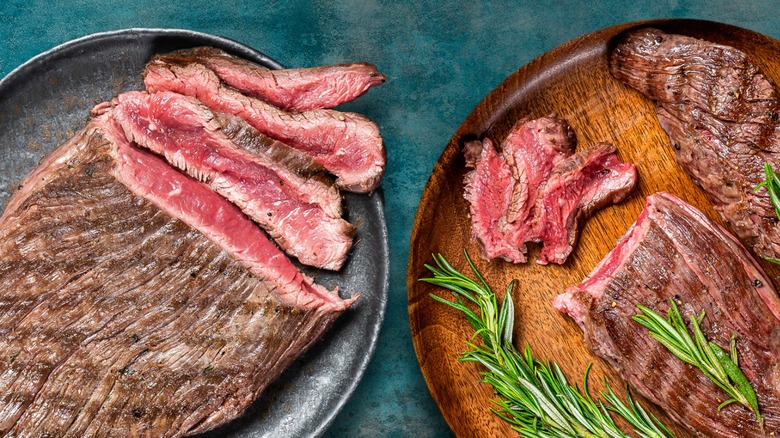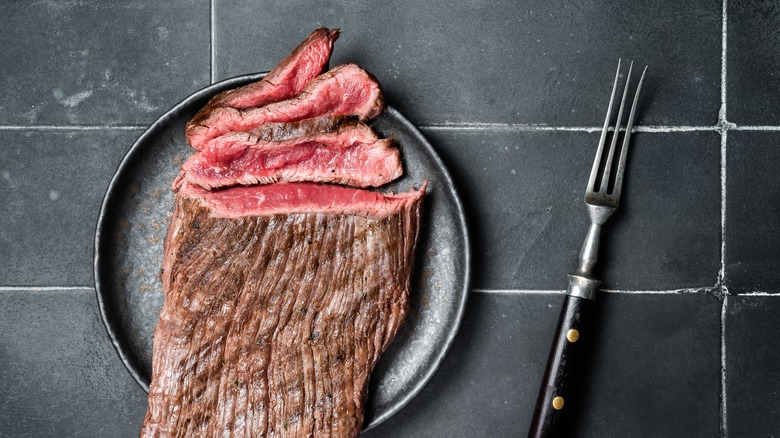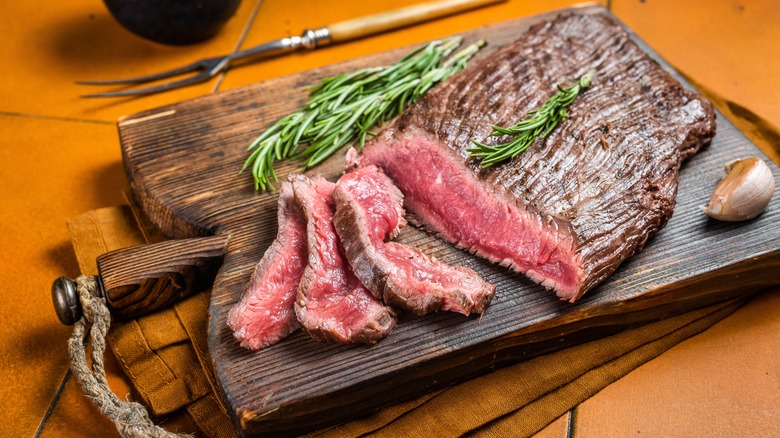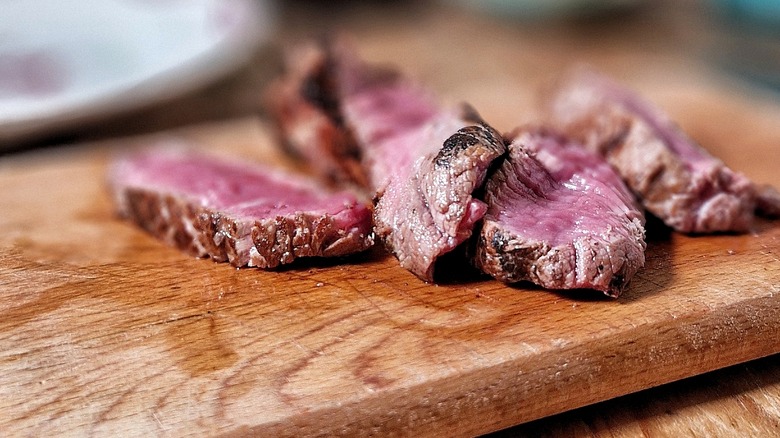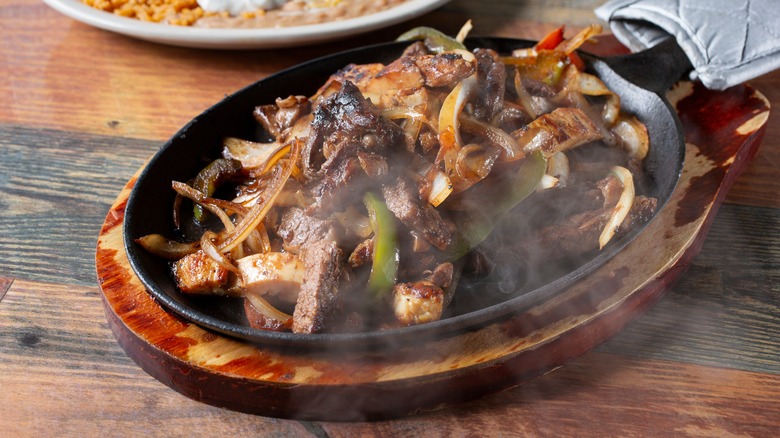Is There A Difference Between Flap And Flank Steak?
These two cuts of steak are versatile and unique — admittedly lesser-known than the T-Bone or New York Strip but no less underrated for their lack of press. Flap steak and flank steak are strikingly similar but far from interchangeable; sisters but not twins. Both are historically regarded as butchers' well-kept secrets. They also come from similar parts of the steer, the belly muscle, which can make differentiating them a tough task at first glance.
What's easier than telling them apart is identifying this duo in the first place. Both flap and flank steaks often have one end that's markedly thicker than the other end. This can be a beneficial aspect for pleasing a crowd, as one side of the steak will lean rare while the other will be medium-well. This aspect also totally works for recipes that call for the steak to be cut into thin strips. Otherwise, if you're preparing the flap or flank steak as an intact entree, the thinner end will need to be removed from heat midway through the cooking process for a uniform sear.
But from there ... what's the difference? The most obvious distinction between flap and flank steaks is that flank steak is wedge-shaped and smaller than the slab-shaped flap steak. But their idiosyncratic differences also give flap and flank steak different cooking methods and make them better contenders for different dishes.
What is flap steak?
Flap steak (aka bottom sirloin butt, Bavette, or Bistro steak) comes from the mid-rear of the steer near the round and shank. It belongs to the lower part of the sirloin primal around the abdomen, making for a coarse, large grain and tender bite with the proper preparation. Flap steak also carries minimal gristle and membrane to be trimmed (hello, short prep time) and considerable mouth-watering fat marbling.
In some markets, raw flap steak is sold as "sirloin tips" and is pre-sliced into cubes or long strips. But to be clear, we're specifically talking about the large, intact slab version of the steak. Foodies in major cities or with a reputable local butcher are more likely to spy flap steak in the display case than folks searching the supermarket (in which case, Sprouts is our favorite grocery store for a consistently knockout meat selection, for the record). It's less common than other popular cuts like porterhouse, but once you do track it down, we're all about this sweet-savory cherry balsamic flap steak with fresh thyme and a tender, toothy texture.
What is flank steak?
Flank steak (aka Jiffy steak or London broil) comes from the lower chest of the steer, just below the bottom sirloin (where the flap is) but behind the plate and before the shank. It's a tough abdominal muscle, which accounts for the cut's relatively low price tag. But flank steak is also a long, flat cut with low fat and a big beefy flavor, making it a versatile fit for lots of different recipes. Here at Tasting Table, we're digging this grilled balsamic flank steak.
Compared to flap steak, flank steak is also more widely available at grocery stores and butcher counters. It's popular in Chinese markets and is commonly used in stir-fry dishes. It's also a popular cut in the culinary styles of Brazil, where it's called fraldinha or vazio, and in Colombia, where it dons the name sobrebarriga, which aptly means "over the belly." As you shop for flank steak, look for uniform flatness, as little fat as possible, and dark red hue.
Flank steak is easy to overcook
When it comes to preparing flap steak, cutting after cooking is generally the way to go. Flap steak should be cooked intact in its large slab form. Thanks to its thinness, flap steak cooks through quickly and should ideally be prepared over high heat with frequent flipping to achieve a smoky, charred exterior and rare pink insides. Just a few minutes per side should do the trick. As with any steak, don't forget to let your meat rest for a few minutes before cutting in, and keep an eye on the temperature as it sits.
When it comes to flank steak, hot and fast cooking also applies. Just take care to avoid overcooking flank steak, as those muscle fibers can become unpleasantly tough. Anything above medium-rare is in the danger zone. Veer on the rare side to be safe. Flank steak performs well when grilled, broiled, pan-seared on the stove, or slow-braised to break down all of that dense connective tissue.
For maximum tenderness, slice both flap and flank steaks against the grain to serve — an easy feature to find due to the large grain size. Thanks to its coarse grain and loose connection between the meat and muscle fibers, these steaks also tote large spaces for flavorful rubs and marinades to soak in. Opt for high-acid marinades to tenderize these sub-abdominal cuts' tougher muscle fibers, like black garlic, teriyaki, miso, or red wine.
Flap steaks are great for slicing, while flank steaks work for entrees
Flank steak and flap steak are flavorful, chewy, and typically affordable compared to other popular cuts. Even though they tend to tote similar price tags, raw flap steaks at the market tend to weigh between three and four pounds, whereas raw flank steaks clock in slightly smaller at around two pounds on average. Depending on what dish you're making, one might perform better than the other. Flap steak is a terrific candidate for grilling and works well for slicing, making it a popular choice for steak tacos, carne asada, fajitas, stir-fries, sandwiches, and steak salads. Hearty flap steak is a fitting substitute for most recipes that call for skirt steak, and it can also be trimmed into large steaks and paired with side dishes as an entree on its own, but this is less common.
Flank can also be cut into strips but is commonly served as a whole steak or London broil, sliced against the grain at a 45-degree angle. Unlike flap steak, flank steak is a prime (pun intended) contender for rolling and stuffing with other flavorful ingredients, as in this Spicy Beef Braciole, crafting an elegant and impressive entree for dinner party guests. Goat cheese, herbs, spinach, and mushrooms all work well for stuffed flank steak fillings.
